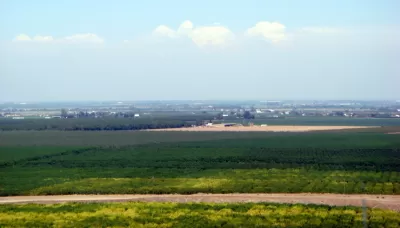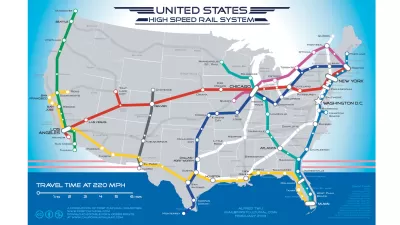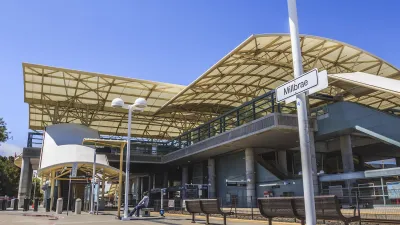Delays in acquiring properties are costing the project significant amounts of time and money.

Ralph Vartabedian reports on the status of the California High-Speed Rail Authority’s acquisition of land in the Central Valley. “The slow progress in many cases has pushed back construction timetables for the Los Angeles-to-San Francisco system, caused delay claims by contractors and hardened the emotions of some property owners.”
The project is already 13 years behind schedule, and the budget overrun is at $44 billion. In the Central Valley alone, the initial cost estimate of $332 million to acquire properties has skyrocketed to $1.5 billion. “There are fights about farm wells and trellises. Debates about the value of nut trees apart from the land where they grow. And tears shed over the loss of land held by families for more than a century,” says Vartabedian.
The authority still needs to acquire 160 of 378 parcels in Kings County. The area has complex agricultural systems, and resistance from farmers has been intense. “When a track cuts a vineyard diagonally, for instance, the trellis structure and the grape vines must be either removed or restrung. That can curtail production for years and the state has to pay for it, farmers say,” reports Vartabedian.
Adding to the slow progress is the fact that one judge from Southern California is hearing the disputes, since all of the county’s superior court judges have recused themselves, and Caltrans lawyers representing the authority are scattered throughout the state.
“The rail authority has acknowledged that it made serious errors in the Central Valley, issuing construction contracts before land was in hand and underestimating the difficulty of the process. It has vowed to not repeat those errors. But fixing what is already broken has become a long process,” notes Vartabedian.
FULL STORY: Bullet-train land acquisitions are moving so slowly a judge hearing the cases calls it a ‘lifetime job’

Trump Administration Could Effectively End Housing Voucher Program
Federal officials are eyeing major cuts to the Section 8 program that helps millions of low-income households pay rent.

Planetizen Federal Action Tracker
A weekly monitor of how Trump’s orders and actions are impacting planners and planning in America.

Ken Jennings Launches Transit Web Series
The Jeopardy champ wants you to ride public transit.

Rebuilding Smarter: How LA County Is Guiding Fire-Ravaged Communities Toward Resilience
Los Angeles County is leading a coordinated effort to help fire-impacted communities rebuild with resilience by providing recovery resources, promoting fire-wise design, and aligning reconstruction with broader sustainability and climate goals.

When Borders Blur: Regional Collaboration in Action
As regional challenges outgrow city boundaries, “When Borders Blur” explores how cross-jurisdictional collaboration can drive smarter, more resilient urban planning, sharing real-world lessons from thriving partnerships across North America.

Philadelphia Is Expanding its Network of Roundabouts
Roundabouts are widely shown to decrease traffic speed, reduce congestion, and improve efficiency.
Urban Design for Planners 1: Software Tools
This six-course series explores essential urban design concepts using open source software and equips planners with the tools they need to participate fully in the urban design process.
Planning for Universal Design
Learn the tools for implementing Universal Design in planning regulations.
Ada County Highway District
Clanton & Associates, Inc.
Jessamine County Fiscal Court
Institute for Housing and Urban Development Studies (IHS)
City of Grandview
Harvard GSD Executive Education
Toledo-Lucas County Plan Commissions
Salt Lake City
NYU Wagner Graduate School of Public Service





























